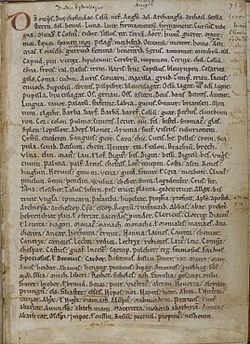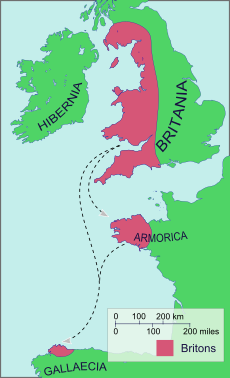Vocabularium Cornicum facts for kids
Quick facts for kids Vocabularium Cornicum |
|
|---|---|
| British Library | |

The first page of Vocabularium Cornicum, a 12th-century Latin-Old Cornish glossary
|
|
| Also known as | Old Cornish Vocabulary; Cottonian Vocabulary |
| Type | Glossary |
| Date | c. 1200 |
| Language(s) | Old Cornish, Medieval Latin, Old Welsh, Old English, Old French |
| Scribe(s) | Unknown |
| Author(s) | Unknown |
| Material | Vellum |
| Size | 210 x 145 mm; 4 sides; 7 leaves |
The Vocabularium Cornicum is an old book that works like a dictionary. It's also called the Cottonian Vocabulary or the Old Cornish Vocabulary. This special book helps us understand the Old Cornish language because it lists Latin words and then gives their meaning in Old Cornish.
Experts believe it's a Cornish version of an older Latin-Old English dictionary. That original dictionary was created by a monk named Ælfric of Eynsham. The Vocabularium Cornicum is the most important old document we have for the Old Cornish language. The only copy that still exists is kept safe in the British Library. It was probably copied around the year 1200 AD from an even older version.
Contents
The History of the Cornish Language
To understand the Vocabularium Cornicum, it helps to know a bit about the history of the Cornish language. After the Romans left Britain in the 5th century, Germanic tribes started to settle there. They spoke different languages.
The Common Brittonic language, which was spoken across most of Roman Britain, was pushed west. Over time, it split into different languages. One of these was Western Brittonic, which became Welsh. Another was Southwestern Brittonic, which became Cornish and Breton. This happened as Anglo-Saxon groups moved further west.
By the time the Vocabularium Cornicum was written, the Southwestern Brittonic languages in Britain were mainly spoken in the area west of the River Tamar. This area is roughly where the historic county of Cornwall is today. The language spoken there had developed into what we call Old Cornish. Some experts, like Kenneth H. Jackson, say the text is a mix between Old Cornish and Middle Cornish.
When Was It Written?
Kenneth Jackson thought the copy of the Vocabularium Cornicum we have was made at the end of the 12th century. He believed it was a copy of an original text from around 1100. This original might have been made in south-east Wales.
However, most modern experts now think the original was made later, around 1150, or in the second half of the 12th century. It was probably created in Cornwall or by someone who spoke Cornish. The copy we have is now part of the Cotton library collection at the British Library.
What's Inside the Book?
The Vocabularium Cornicum is part of a larger collection of texts called MS Cotton Vespasian A XIV. This collection includes writings from the early 11th to the late 12th century. Besides the Latin-Old Cornish dictionary, the rest of the manuscript contains Welsh texts. These include a calendar of Welsh saints and a story about the founding of Brycheiniog.
How the Book Looks
Only one copy of this document still exists. It was written with ink on sheets of parchment, which is a type of animal skin used for writing. It has seven pages, from page 7r to 10r of the larger manuscript. Each page is about 5 ¾ by 8 ¼ inches (210 x 145 mm).
How the Dictionary is Organized
The dictionary follows the same structure as Ælfric's original Glossary. It lists words in a similar order. The Old English explanations in Ælfric's book were replaced with Old Cornish ones.
The words are grouped by topic. For example, it starts with words about God, heaven, and angels. Then it moves to things from the Genesis creation narrative, like stars, the sun, moon, Earth, and sea. After that, it covers many other topics:
- Parts of the body
- Church roles
- Family members
- Jobs and tools
- Feelings and illnesses
- Legal words
- Weather, time, and seasons
- Colors, animals (birds, fish, insects, mammals)
- Plants (herbs, trees)
- Places (topographical features)
- Buildings and household items
- Clothes, food, and drink
The dictionary ends with some descriptive words (adjectives) and the Cornish word for 'saddle'. In total, it has 961 words, which is fewer than the 1,269 words in Ælfric's original.
How Words are Referenced
When people talk about words from the Vocabularium Cornicum, they often use a special number. This number comes from a study by Eugene Van Tassel Graves. For example, "VC 1" means the very first word in the text. This word is "Deus omnipotens . duy chefuidoc", which means 'almighty God'.
The Words Themselves
Cornish is a Celtic language. About three-quarters (73%) of the words in the Vocabularium Cornicum are Celtic. Here are some examples:
- VC 32 nef 'heaven, sky'
- VC 35 tir 'land'
- VC 40 pen 'head'
- VC 128 lester 'vessel'
- VC 58 euuin 'nail'
When the Romans were in Britain, the Common Brittonic language borrowed many words from Latin. These loanwords became part of the language. The Vocabularium Cornicum shows many of these words. About 19% of the words probably came from British Latin. Examples include:
- VC 73 brech 'arm'
- VC 235 ruid 'net'
- VC 848 cos 'cheese'
There are also a few words borrowed from Old English (5%) and Old French (2%). About 1% of the words have an unknown origin.
- Old English loans: VC 711 ford 'way', VC 796 hos 'boot', VC 229 creft 'art'.
- Old French loans (likely borrowed through English): VC 167 emperor 'emperor', VC 232 inguinor 'craftsman', VC 419 fol 'foolish'.
For a long time, people thought this text was Welsh. In the Cotton library, it was even called a Latin-Welsh Vocabulary. However, in 1707, Edward Lhuyd showed that it was actually Old Cornish.
Interestingly, there are some Welsh words in the book too. Sometimes they appear next to their Cornish equivalent, linked by a symbol that means 'or'. For a few words, only a Welsh meaning is given. Sometimes the Cornish word comes first, like for 'cheese': "cos ł caus". Other times, the Welsh word comes first, like for 'hand': "lau ł lof".
Because Old Welsh, Old Breton, and Old Cornish were very similar back then, many words would have looked almost the same in all three languages. One expert, Alderik Blom, thinks about 35% of the words would have been spelled nearly identically in Cornish and Welsh. Still, some words are clearly Welsh or show Welsh features. Oliver Padel estimates that:
- 503 words are definitely Cornish.
- 305 words could be Cornish or Welsh.
- 38 words are Welsh or have Welsh features.
- 94 words are unknown or "not Brittonic."
Kenneth Jackson suggested that the person who copied the book might have been Welsh. This copyist might have added or changed some words to Welsh while copying the original Cornish text.


